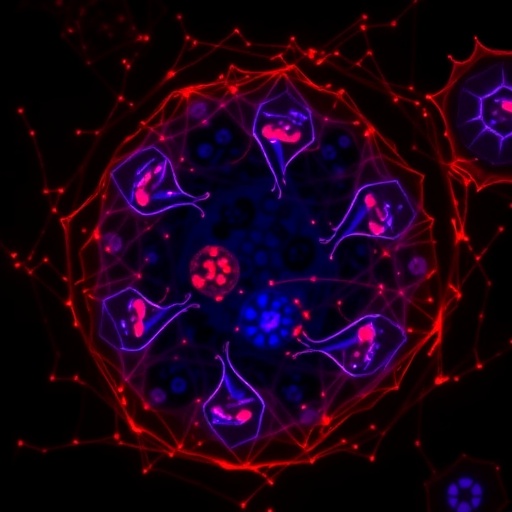In a groundbreaking advancement for cellular biology and nanotechnology, researchers I. Barth and H. Lee have unveiled a revolutionary nanophotonic sensing and imaging platform capable of detecting extracellular vesicles (EVs) with unprecedented precision and without the need for labeling. Published in Light: Science & Applications, their 2025 study propels forward the field of bio-nanophotonics by introducing a technique that promises to dramatically enhance our ability to study nanoscale biological entities, paving the way for novel diagnostic and therapeutic applications.
Extracellular vesicles, tiny membrane-bound particles released by cells, have emerged as pivotal players in intra- and intercellular communication. Because they carry biomolecules reflective of their cells of origin, EVs have drawn significant interest as potential biomarkers for a multitude of diseases including cancer, neurodegenerative disorders, and infectious diseases. However, their nanoscale size—ranging from 30 to 150 nanometers for exosomes—renders their detection and imaging an enduring technical challenge, one that traditional fluorescence labeling methods attempt to overcome but often suffer from drawbacks such as photobleaching, non-specific binding, and complex sample preparation.
The research conducted by Barth and Lee circumvents these limitations by employing a nanophotonic platform that leverages the interaction between light and engineered nanostructures to both sense and image EVs in their native, label-free state. This methodology capitalizes on the enhanced electromagnetic fields generated by resonant nanostructures, which significantly amplify the optical signals from individual vesicles without any fluorescent or chemical modifications. This label-free approach not only preserves the biological integrity of the vesicles but also facilitates real-time analysis with high sensitivity.
Central to this advancement is their use of meticulously designed plasmonic nanoantennas integrated on a photonic chip. These nanoantennas interact with incident light to create localized surface plasmon resonances—collective oscillations of electrons at the metal-dielectric interface—that dramatically enhance the electromagnetic field in the immediate vicinity of the vesicles. When an extracellular vesicle binds or passes near these hotspots, subtle variations in the optical response can be detected with precision, allowing for the real-time monitoring of EV dynamics.
Furthermore, the optical setup utilizes advanced interferometric detection schemes that enhance the signal-to-noise ratio, pushing the detection sensitivity down to single-vesicle resolution. This is crucial because it opens the door to isolating and characterizing heterogeneous populations of EVs, which was hitherto near-impossible due to ensemble averaging effects in bulk measurements. Their system can discriminate between vesicles based on size, refractive index, and potentially biochemical composition inferred from their optical signatures.
In addition to sensing capabilities, the platform excels at label-free imaging through near-field optical techniques. By capturing the interference patterns generated when light interacts with nanometric EVs on the metasurface, high-contrast images can be reconstructed without fluorescent tags. This confers a significant advantage for longitudinal studies of EVs, as it avoids phototoxicity and permits continuous observation over prolonged periods, thereby offering insights into their biophysical behavior and payload release mechanisms.
The implications of this work are extensive. For biomedical research, this development means better tools for early disease diagnosis via liquid biopsies, where EVs from bodily fluids could be analyzed rapidly and non-invasively. It also opens the prospect of monitoring treatment responses by tracking changes in EV populations, potentially enabling personalized therapy adjustments. Furthermore, this platform could be adapted for high-throughput screening applications, revolutionizing how extracellular vesicles are studied and utilized clinically.
The nanophotonic chip’s compatibility with existing microfluidic systems enhances its utility, enabling integration into compact lab-on-a-chip devices. Such miniaturization holds promise for point-of-care diagnostics, where rapid, sensitive, and label-free EV detection could become routine. The researchers are optimistic that with further development, portable devices based on this technology will facilitate widespread clinical adoption.
Moreover, the fundamental insights obtained from their sensing and imaging approach contribute to the broader understanding of vesicle biology. Detailed characterization of EV populations relative to different cell types and conditions may uncover novel biomarkers or therapeutic targets. The researchers anticipate that coupling this method with complementary analytical techniques such as mass spectrometry will paint a more complete molecular picture of EV contents.
Technically, the platform’s sensitivity hinges on the precise fabrication of the plasmonic nanoantennas, achieved through state-of-the-art electron beam lithography and cleanroom processes. This level of nanoscale engineering ensures reproducibility and robustness of the optical responses. From an instrumentation perspective, the team employs tunable laser sources and sensitive photodetectors combined with sophisticated data processing algorithms that extract meaningful signals from subtle optical modulations caused by single vesicles.
The study also addresses challenges such as minimizing nonspecific adsorption and maintaining biological sample integrity. Surface functionalization strategies with antifouling coatings were judiciously employed to reduce noise and enhance specificity without compromising EV stability. These careful considerations strengthen the platform’s applicability in realistic biological environments.
Looking forward, the authors suggest expanding the platform’s capabilities to multiplexed detection schemes by engineering arrays of nanostructures resonant at different wavelengths, potentially allowing simultaneous characterization of multiple vesicle types or cargo components. Additionally, integrating machine learning algorithms to analyze optical signal patterns could automate vesicle identification and classification, advancing toward fully autonomous diagnostic systems.
This innovative work not only enriches the nanophotonics toolbox but also exemplifies how interdisciplinary collaboration between physics, engineering, and biology can spawn technological breakthroughs addressing pressing biomedical challenges. As the demand for precise, rapid, and minimally invasive diagnostic tools continues to surge, label-free nanophotonic sensing and imaging of extracellular vesicles may soon become a cornerstone technology transforming healthcare paradigms.
Barth and Lee’s research marks a pivotal milestone in extracellular vesicle analysis, marrying the precision of nanophotonics with the complexity of biological systems to unlock new horizons in disease diagnostics and nanomedicine. Their technology could spark a paradigm shift in how clinicians and researchers study cellular communication at the nanoscale, ultimately enabling earlier disease intervention and the development of tailored therapies rooted in the molecular messaging vehicles—the extracellular vesicles themselves.
Subject of Research: Extracellular vesicles and nanophotonic sensing technologies.
Article Title: Nanophotonic sensing and label-free imaging of extracellular vesicles.
Article References: Barth, I., Lee, H. Nanophotonic sensing and label-free imaging of extracellular vesicles. Light Sci Appl 14, 177 (2025). https://doi.org/10.1038/s41377-025-01866-2
Image Credits: AI Generated




